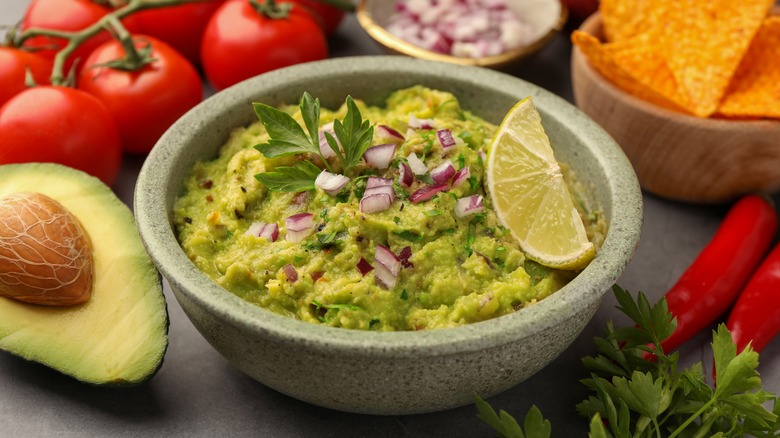Store Guacamole With A Layer Of Water To Prevent It From Browning
There's nothing worse than painstakingly pounding together the best guacamole dip using a molcajete (similar to a mortar and pestle), only to find that it's faded into an unappetizing shade of brown. All that hard work turned into a drab mush a mere few hours late — such a shame! Fret not though, for it's nothing a nifty kitchen hack can't solve: All you need is a little bit of water.
Simply transfer the guac into a container and smoothen its surface using a spoon, making sure to remove any air pockets trapped in between. Then, gently pour a thin layer of lukewarm water on top until it's about half an inch tall and coats the top of the dip entirely. Seal the container tightly and pop it into the refrigerator — this should keep your guac vibrant and green for about three days. If you're doubtful about the water seeping into the guacamole and making it mushy or weakening its flavor, it's nothing to worry about; avocados have enough fat that they won't absorb the water. All you have to do is pour out the liquid slowly and stir the rest of the dip when you're ready to dig into it.
Why does guacamole brown in the first place?
To understand how water helps guac retain its green vibrancy, it's important to know what causes the browning in the first place. To put it simply, it's nothing but oxidization. Much like apples and bananas that turn brown when cut, avocadoes release an enzyme known as polyphenol oxidase when they are sliced or pounded. When this enzyme is exposed to oxygen, the fruit oxidizes and turns brown — a process that is accelerated when avocados are cut with a metal knife. While this process may negatively impact the nutritional value of the guac as well as its appearance and flavor (browned guac can taste bitter), it doesn't make the dip any less safe to eat.
By adding water on top, you're essentially creating a barrier that prevents the guac from coming into contact with oxygen and changing color. This is why the key here is to make sure that the layer of water is thick enough and that it covers the top surface of guacamole entirely — from one end of the container to the other. That said, because water only works as a shield on top of the dip, it's not the only way to prevent oxidization from happening. Any method that limits the guac's exposure to oxygen can prevent it from browning in theory.
More ways to keep your guac green
Water aside, there are other liquids that you can cover the guac in to prevent it from browning. Brushing the top layer of the dip with a little bit of oil or cooking spray can also form a protective barrier against oxygen. Cover the guac with an airtight lid or seal it with plastic wrap afterward and your guac should stay green for anywhere between one to two days. The only downside here is that the dip will have a noticeably oily glean on top.
Lime juice is another liquid that can come to the rescue. The ascorbic acid present in the citrus juice may not prevent oxidization entirely, but it can certainly slow it down. Simply pour a layer of lime juice on top of the dip as you would water, and then either drain the liquid when you're ready to eat or whisk it into the guac if you don't mind the added tang.
Storing guac with an avocado pit or leaving half an onion inside are two other popular tricks. While sliced onions do work when storing cut avocados, both hacks do very little to prevent oxidization in guacamole. In reality, you'd be better off sealing the dip tightly instead, using things like wax paper, plastic wrap, or dedicated gadgets such as Guac-Lock to keep the dip from browning.



